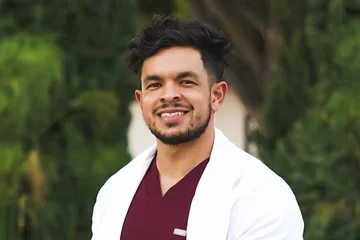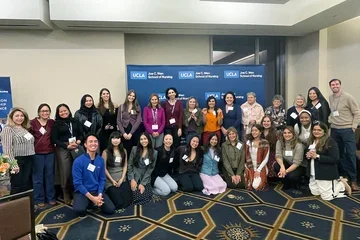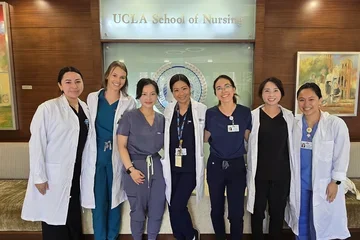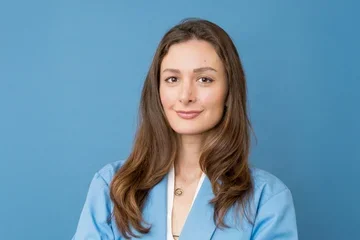Meeting Community Needs
Through expanding educational pathways at all levels — including the newly established Post BSN-DNP program — UCLA Nursing is addressing the most critical challenges facing nursing and healthcare

When Gloria Garcia entered the UCLA School of Nursing’s Bachelor of Science in Nursing prelicensure program as a transfer student in the fall of 2023, it represented the fulfillment of a dream, and the culmination of an unlikely journey.
Born and raised in Guadalajara, Mexico, Garcia was an A student with an interest in science and healthcare ignited by her love of the popular Grey’s Anatomy television series. But unlike many classmates inspired by a family member or other adult mentor to pursue a nursing career, Garcia never gave nursing a second thought until an experience she had as a patient in a small, low-resource clinic in her hometown when she was 17.
“I was sitting there observing all of these overworked, underpaid staff members,” Garcia recalls. “But then I saw this nurse, and she looked so happy. She was sweaty, with her hair all over the place, but she was so welcoming and empathetic with her patients, and seemed very content in her role. I never got her name, but after seeing her, I decided that was who I wanted to be.”
Garcia’s father had moved to Mexico after earning his degree in California, and throughout Gloria’s childhood, her parents had spoken of an eventual move to the U.S., where she and her two sisters could pursue college education. In 2018, Garcia’s senior year of high school, the family settled in Visalia, a small community in California’s Central Valley.
By then, Garcia was determined to do what she could to qualify for a prestigious nursing school. After completing high school online and earning her GED while attending an English as a Second Language program, she enrolled in a community college to fulfill the science prerequisites that would allow her to apply as a transfer student. During that period, one of her sisters bought Garcia a UCLA blue and gold sweatshirt. “I wore it all the time, even on occasions when everyone was dressed up,” she recalls, smiling. “In my mind, that was my school.”
By the time Garcia was ready to apply, UCLA Nursing had just welcomed its largest-ever transfer class. Support from the University of California system and a grant funded by the California Department of Health Care Access and Information allowed the school to more than double its transfer student scholars. The Song-Brown grant, awarded to Dr. Robert Lucero, UCLA Nursing professor and the Inaugural Audrienne H. Moseley Endowed Chair in Equity, Diversity, and Inclusion, aims to increase the number of diverse students receiving quality higher education and skills training to address unmet needs throughout California.
The expansion of the BS prelicensure transfer program is one of a multitude of ways in which the school is helping to meet the abundant needs of the nursing workforce, through both existing programs and the initiation of UCLA Nursing’s newest pathway — the Post Bachelor of Science in Nursing to Doctor of Nursing Practice (Post BSN-DNP), which will prepare RNs to become experts and leaders in advanced practice while completing a clinically oriented doctoral degree in nursing. The Post BSN-DNP Program welcomes its inaugural cohort in fall 2025.
“The nursing shortage is a massive national and global problem, both overall and in specific areas across healthcare settings,” says Dr. Barbara Bates-Jensen, professor and associate dean for academic affairs at the school. “The goal of our education programs is to help provide the nurses needed for both California and the U.S., and we are doing that at all levels.”
The American Hospital Association has estimated that 1.1 million more bedside nurses are currently needed, and as the population ages that number is likely to increase. “The COVID-19 pandemic was extremely hard on nurses, causing a lot of burnout — and not just among those who were ready to retire, but also young nurses,” Bates-Jensen says.
The school is doing its part to ease the shortage of bedside nurses through its BS prelicensure program for both freshman and transfer students, and through the two-year Master’s Entry Clinical Nursing (MECN) program. The MECN program enables individuals who have a degree in another field — and, for some, an established position in another profession — to enter at the master’s level, pivoting to a career as a bedside or public health nurse. Bates-Jensen notes that both prelicensure programs have begun to incorporate the new American Association of Colleges of Nursing Essentials for prelicensure education into the curriculum as part of a national movement toward competency- based education.
Some of the most acute areas of shortage will be addressed by the advanced practice nurses who enroll in UCLA Nursing’s newest educational pathway, the Post BSN-DNP. Bates-Jensen points out that as the population ages, more elders are requiring care that is both expensive and complex. “We have growing numbers of people with multiple chronic conditions to manage, and we have far fewer primary care physician providers who work with this population than we need,” Bates-Jensen says. “This creates a great demand for advanced practice registered nurses trained in adult geriatric care, since we know from multiple studies that nurse practitioners provide care equal to, if not better than, physician primary care providers.” Nurse practitioners are also ideally suited to address other areas of dire need, including in mental and behavioral health, pediatrics, and women’s health, Bates-Jensen adds.
The Post BSN-DNP will prepare BS-educated registered nurses to become nurse practitioners, as well as providing them with doctoral-level knowledge and skills in advanced nursing practice, organizational and systems leadership, quality improvement and evidence-based practice, healthcare policy, population health, ethics, interprofessional collaboration, and quality and safety of patient care. Students will be able to choose from one of four specialties: Adult/Gerontology Acute Care Nurse Practitioner; Adult/Gerontology Primary Care Nurse Practitioner; Family Nurse Practitioner; and Pediatric Dual Primary/Acute Care Nurse Practitioner.
Dr. Theresa Brown, UCLA Nursing assistant adjunct professor and director of the program, explains that as a practice-oriented degree, the DNP focuses on translational science aimed at improving clinical outcomes. “Health sciences research findings can take years to be implemented at the bedside,” she says. “Our DNPs bridge academia and practice — promoting evidence-based care by bringing the findings to clinical settings much faster to improve patient outcomes.”
The three-year Post BSN-DNP curriculum is being developed in partnership with colleagues from UCLA Health and its affiliates, some of whom will also participate in the teaching, Brown notes. Students will spend much of their first year taking DNP theory courses, with clinical courses introduced in the second year to ensure they are prepared for their national certification exams when they graduate. As part of the program, they will analyze and synthesize research findings on their project’s topic, followed by the implementation of their project in a practice setting.
The trend toward advanced practice nurse practitioners obtaining their DNP is reflective of nurses’ growing role in healthcare. “This is the wave of the future,” Brown says. “Nursing represents the largest profession in healthcare, and yet in the past we have had a small voice because not enough nurses get involved in health policy and legislative activities. The DNP opens your eyes to see the broader picture, understand the issues and where the problems are, and then play a leadership role in implementing evidence-based changes.”
The national nursing shortage is compounded by the significant shortage of nursing faculty. In that regard, the school’s PhD program is fulfilling a critical need by preparing individuals who will both build on the science that supports nursing and be equipped to teach the next generation of nursing students.
There is also a strong need to bring more diversity to the nursing profession, as well as to nursing faculty. In California, where Hispanics make up approximately 40% of the population, less than 10% of the RN workforce is Hispanic. Nationally, less than 5% of nursing faculty are Hispanic. At UCLA and five partner campuses, these shortages are being addressed through a program in which underrepresented students in baccalaureate, master’s, and DNP programs receive mentoring and research experience designed to increase the likelihood that they will pursue a PhD and become nursing faculty.
The Nursing Professoriate Pathway Program (NP3) will recruit and support underrepresented students over a five-year period for what Dr. Robert Lucero, UCLA Nursing professor and the Audrienne H. Moseley Endowed Chair in Equity, Diversity, and Inclusion, calls a “system-level intervention” that enriches their nursing education. The program is part of the University of California Office of the President’s Hispanic Serving Institution Doctoral Diversity Initiative, which aims to attract underrepresented students to doctoral programs toward the goal of developing nursing faculty reflective of the state’s diversity. The program leverages the expertise of five federally designated Hispanic Serving Institutions, one Minority Serving Institution, and two healthcare systems in Southern California. UCLA Nursing’s partner institutions include Mount Saint Mary’s University Nursing Department; three California State University nursing schools (Los Angeles, Long Beach, and Channel Islands); Charles R. Drew University of Medicine and Science’s Mervyn M. Dymally School of Nursing; UCLA Health Nursing; and Cedars-Sinai Nursing.
At the heart of the year-long NP3 program is a four-week summer immersion experience that instills in participants the knowledge and skills they need to conduct academic research and pursue a career in the professoriate. Trainees engage in research at least 20 hours per week, including one-on-one meetings with mentors, lab meetings, journal clubs, research presentations/seminars, and independent research. The participants then continue engaging with their mentors through the following spring, culminating in a podium presentation of the research they conducted. “We are building a community of learners and scholars who can benefit not only from their mentors, but also from the influence of their peers,” Lucero says. He notes that 80% of the first cohort, after completing the 2024 summer immersion, reported that they plan to apply to a PhD program, and all of these students intend to apply to UCLA.
UCLA Nursing has been all that Gloria Garcia hoped it would be, and then some. “Last year, we had guest speakers come to my lectures from different nursing areas, and it was incredible to see all of the possibilities for my future,” Garcia says.
In September, as she started her second of three years in UCLA Nursing’s BSN program, Garcia joined her classmates in the Skills & Simulation Lab for the first time, learning about sterile gloving technique. “After a year of theory, I had the opportunity to put on scrubs,” Garcia says. “I was nervous, but the other students and professors were so supportive. I felt like a nurse, and it was amazing.”



